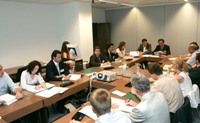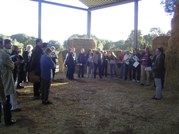TNC Planning
Preparing a cooperation project
Meeting your partner(s) and agreeing to cooperate
What you have already done at this stage:
- Your local stakeholders are aware and mobilised;
- You have defined your cooperation strategy;
- You have identified your cooperation ideas and partners;
- You have your cooperation idea(s); and
- You have identified your potential partner(s).
Preparing and organising a visit to your partner
The first meeting with your partner should be carefully prepared in order to improve the chances of good results. Of course, more meetings may be needed...
Before the meeting:
- Do some structured preliminary work with partner(s) - share information about the situation and the challenges of your area, about the outline of your cooperation project (clarify what you imagine, confirm what your partners imagine and what you could do together). It can be useful to exchange documentation about the partners’ areas and projects (sometimes, translation of such documents might be needed);
- Exchange views with the partner(s) about the programme of the meeting/visit; Agree the working language. This first meeting is a crucial moment and ideally everybody should speak the same working language. If not, you should plan for interpretation. Separate interpreters are very useful and allow LAG staff to concentrate their minds on the project, rather than thinking about translations;
- Mobilise local stakeholders to attend this meeting;
- Decide the composition of your delegation. The ideal ‘team’ should include the LAG manager, representative of the LAG’s technical team, project promoter, LAG elected representatives, and possible financial partners;
- Identify a moderator for the meeting(s) and a person who will prepare the report of the meetings;
- Prepare a presentation of your territory’s context, its challenges and the potential added value of the cooperation project for your territory. Videos can be more attractive than PowerPoint presentations; (see template for describing your territory; Example of a project presentation
- Organise some gifts, such as local products, to thank your partner(s).
During the meeting:
- All participants introduce themselves;
- Presentations of each partner - territory, structure, administrative organisation, etc.; Discussion about individual and common cooperation objectives by each partner – what each of them expects from the cooperation project; and
- Define different roles and agree responsibilities between partners (including the ‘lead partner’), the budget and the next steps.
After the meeting:
- Promptly prepare a draft report of the meeting(s)/visit. Send this to partners for comments and validation; and
- Plan a report for the project’s local stakeholders in your area, to inform them about their (potential) partners.
Preparing and organising a visit from your partner(s)
Besides the above advice, if it is your turn to welcome your partner(s), you should plan specific actions:
- Propose a programme to be agreed by all partners before the meeting;
- Organise of a guided tour of the territory and study visits to help your partner(s) understand the characteristics and the challenges of your territory; and
- Mobilise local stakeholders (including elected representatives) and involve them in the dynamics of cooperation. Proto-type partnership activity: study visit
Confirming the partnership
It is important to conclude this stage at the end of the initial meeting/visit.
Preparing a report document provides a useful means to confirm whether or not the partnership can set-up the first decisions.
Cooperation agreements are rarely signed at the very first meeting. To make sure everyone is aware of what the project entails, it makes sense for the partners to draw up and sign a Letter of Intent in which they outline their intentions and aims. While the letter is non-binding, it pays to document intended cooperation project activities as early as possible as this demonstrates to the approval authority that the partners mean business.
The Letter of Intent should contain the names of the cooperation partners, a working title for the project, the planned areas of activity and a brief description of the project aims. A copy should be supplied to each of the project partners. See template for letter of intent to establish a TNC project
More complex partnership agreements can be set out in a Memorandum of Understanding (MoU). MoUs are often produced to formalise and make explicit important agreements. MoUs are not normally binding legal agreements but they establish matters such as: who will be the lead partner; who will coordinate the proposal writing; and/or the preparation of the funding application, etc.








